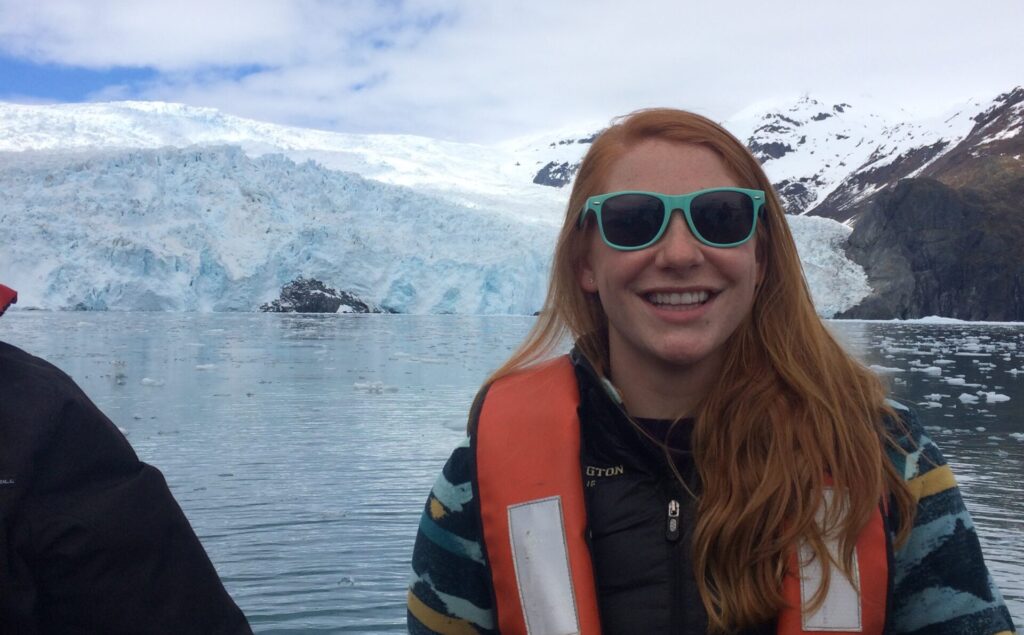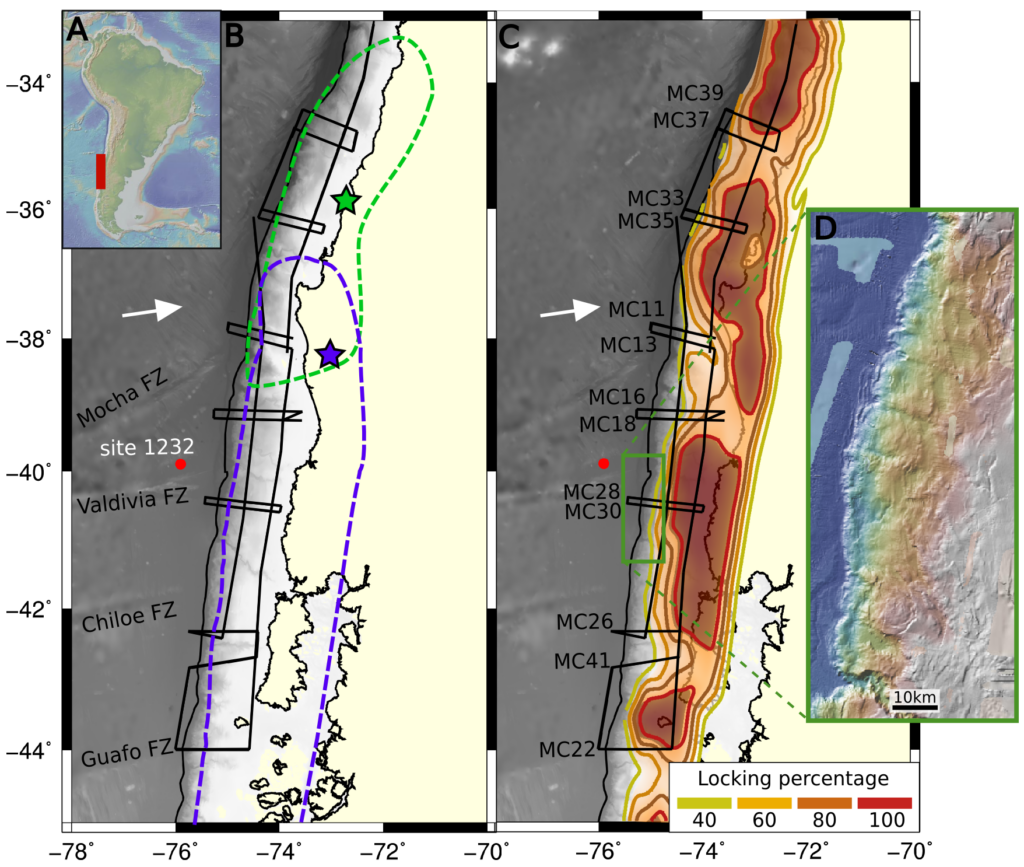
The final UTIG seminar of the Fall semester is reserved for graduate students to practice their presentations for AGU Fall. This year’s practice talks will be given by UTIG grad students Xian Wu, Kelly Olsen and Janaki Vamaraju. We asked each student to give us a sneak-preview into what they’ll be talking about and why they’re excited about sharing their research with the science community.
The seminar takes place at 10:30am (CST) on Friday, December 6 at UTIG. Click here to watch the seminar online.
Name: Kelly Olsen
Degree: Marine geophysics PhD
Funding: NSF, CEVICHE (Crustal Experiment from Valdivia to Illapel to Characterize Huge Earthquakes)
Expected Graduation: Spring 2021
Hi Kelly. Last time we met, you’d just returned from the Mojave Desert. Are you here to talk about tremors in the desert?
That was actually a service trip for another project. The study area for my talk is south-central Chile.
Ooh Chile! So, mountains, alpacas and red wine?
South-central Chile is the location of the strongest earthquake ever recorded, a magnitude 9.5 earthquake in 1960. In 2010, it was also the location of a magnitude 8.8 earthquake, the sixth strongest ever recorded. Both generated big tsunamis and destroyed communities, leading to catastrophic loss of life. So, the reason we study this region is to figure out what’s going on there and why it experiences such strong earthquakes.
I’ve heard strong earthquakes are linked to subduction zones, like off the coast of Japan or Cascadia in the northwest US. Is that what’s going on here?
Subduction zones are the area where one tectonic plate slides beneath the other. Oftentimes those are made of magmatic oceanic crust material – a kind of very hard rock – but they’re covered with a layer of sediments. There are a lot of studies that have looked into the thickness of these sediments and noticed a correlation between areas where there’s really thick sediments and really large earthquakes. The thought is that if you have this smooth lining between the plates it causes stress to build up in one large area, and then ruptures in a big earthquake. If the plates are rough, however, the stress releases unevenly across lots of places leading to lots of little earthquakes.
So do sediments create a smooth layer?

Yeah. A big part of it is because sediments can fill in things like faults leaving a kind of smooth, same-depth layer along the whole area. In Chile we’ve noticed that more than any other subduction zone worldwide, we see a really thick sediment layer, between 1.5 to 3 kilometers thick, where the global average is less than 0.5 kilometers. So, what I’m working on, and what I’m going to be talking on, is investigating why this is happening and what properties of the sediments are causing that.
Aren’t these sediments really deep underground? How do you find out where they come from and what they’re made of?
So there’s a couple ways to go about it. A lot of this stuff is really deep in the earth and it’s underwater, so it’s difficult to study which means we have to approach it in unique ways. One of the things we do is look at structural seismic images that are a bit like what you see from the roadside when the road cuts through a big hill. In the same way, a two-dimensional seismic image lets you see all the layers of rock and sediment.
Like layers in a cake made of rocks and dirt…
Then we looked at seismic velocities, which is how fast sound moves through a material. In general, it moves a lot faster through stiffer, more compacted material, like concrete, than looser consolidated things, like a pile of sand. So we found that velocities seem to be higher than at other subduction zones, which likely means that the sediments might be stronger there.
That sounds pretty conclusive!
That was actually previous work I did. Since then, I’ve looked at fault orientations and the different angles they dip. What we found in Chile is that the angles of the faults are much steeper within the incoming sediment section than other areas, which supports the hypothesis that these sediments are stronger and causing these really large earthquakes you see there.
And what do you think the sediments are made of?
There is only one core that exists from that region that was sampled by the International Ocean Discovery Program (IODP). What they found is that the rocks in the core are turbidites, which are a kind of sedimentary rocks that come from energetic environments such as strong ocean currents or earthquakes and underwater landslides. They start coarser and sandier at the base and then grade up to thinner sediments at the top. There’s a big notable difference between what they found there and some of the other subduction zones, such as areas in Japan or Cascadia, where drilling expeditions found pelagic sediment – or clay – which is a much weaker material. Fluids might also play a role.
One solitary core though, that’s not a lot to work with.
No it’s not, but we have some 5,000km of 2D seismic reflection data we collected off the shore of Chile, covering over 1,000km of the subduction zone. It’s this data that has allowed us to study the sediment thickness, material stiffness and fault orientations. This is what a lot of marine geophysics is like. You can’t just sample everything, you have to use the information you have to try approach the problem at different angles until you narrow it down to the most probable cause.
So if IODP could only manage one core, who gathered so much seismic data?
Actually, we did.
!
We were at sea for forty days between January and February 2017, gathering data using a 15 km long streamer that we reel out from the back of the boat. The streamers have these things called ‘birds’ attached to them which have little wings that allow us to control their depth and position. Then we deploy an array of thirty-six airguns, which the streamers listen for – this creates the seismic reflection image.
Speaking of birds, did you encounter any wildlife?
Yes, it turns out south central Chile has really great fertile waters so we saw plenty of wildlife! On science cruises we travel with protected species observers, who are specially trained to help us look out for nearby wildlife. When seals stray too close, for example, we shut things down to protect the animals from the sound of the airguns. We certainly saw a lot of seals! I think on that cruise we must have shut down over 140 times. One day we had about 100 dolphins swimming with us for hours, which was fun to see but not great for the data. I also saw some whales. We even found some shark teeth in some of the ‘birds’ when we pulled them back in!
What else do you do on these cruises other than reeling out cables and spotting for wildlife?
As a grad student you spend a lot of time staring at screens monitoring the data as it’s coming in, but we also got to learn how to process the data and there were other experiments which involved throwing a sensor overboard to get the temperature and salinity of the water. I had my birthday on there, so that was funny and they made me a carrot cake and sang to me and I got very embarrassed. There’s also a movie room, but I read a lot of books.
How many ocean cruises have you been on?
Two, this one and one in Alaska which I joined as part of the Apply to Sail program. On that cruise we deployed long-period ocean-bottom seismometers, which you throw off the side of the boat and leave at the bottom of the ocean for a year and a half or so.
How do you feel about giving a much coveted UTIG seminar talk?
I don’t typically get nervous giving talks about something I know about but I think I’m more nervous about this than AGU just because I know everyone here, and someone can march into my office afterwards and say, “what you’re doing doesn’t make any sense!” But it will be nice for the work we’re doing to be shared around UTIG a little and let everyone know what we’ve been working on.
Kelly has presented her research as a poster at AGU on two occasions. This will be her first time presenting her research in a talk.
Kelly’s UTIG Seminar talk, which she will also present at AGU Fall 2019, is titled “Strong sediment inputs at the south-central Chile margin revealed from fault patterns in 2D seismic reflection data and the relationship to megathrust earthquakes”.
Good luck with your talks Kelly!
